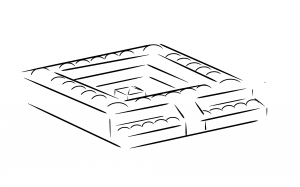 Located in the old Ottoman core of the city of Sarajevo, Tašlihan is one of the representatives of Ottoman architecture and lifestyle in the city on Miljacka. Tašlihan had the largest vakif that Sarajevo remembers built, Gazi Husrev-beg.
Located in the old Ottoman core of the city of Sarajevo, Tašlihan is one of the representatives of Ottoman architecture and lifestyle in the city on Miljacka. Tašlihan had the largest vakif that Sarajevo remembers built, Gazi Husrev-beg.
The main architect of Tašlihan was the famous architect Adžem Esir Ali from the Persian Tabriz, who had previously built the Beg Mosque. Along with Mimar Hajrudin, he was one of the leading creators of the early Constantinople architectural school.
The construction method of Tašlihan and Bezistan was interesting. Architecturally, Tašlihan was a stone building (from the foundation to the ridge), square in shape, built on one floor, topped with domes that were covered with lead. It was both an inn and a bazaar (place for trade). Bezistan was built from the same material and had 52 shops. The domes and vaults were built by masters who were specially ordered from Dubrovnik, as well-known top connoisseurs. Tashlihan also had the function of assembly place, which is less known.
Tashlihan, as well as neighboring Bezistan, shared the same fate. On several occasions, they burned down in a fire, but they were also restored. Tashlihan burned in fires in 1697, 1788, 1831, and 1879. A part of Tašlihan came into private ownership after the fire in 1697, because the foundation could not restore it until 1709. In a fire in 1831, lead melted from the roofs of both Tašlihan and Bezistan. During the renovation of Tašlihan, new stables were built and new guest rooms above them. After the fire in 1879, it was no longer rebuilt, but the remaining part was the garage of Vejsilage Šaračević. In May 1912, the remaining part was demolished because the foundation intended to build a modern building on that site, but they were prevented by the war of 1914.
Although Tashlihan and Bezistan were once compact units, today they stand in complete opposition. Bezistan still serves its purpose, that is, trade, and is in relatively good condition. The neighboring Tašlihan shows the outlines of the former monument. The eastern wall along Bezistan and the fragmentary remains of the walls towards the interior of the courtyard have been preserved. Today, the western part of Tašlihan is covered by the garden of the “Europe” hotel.
